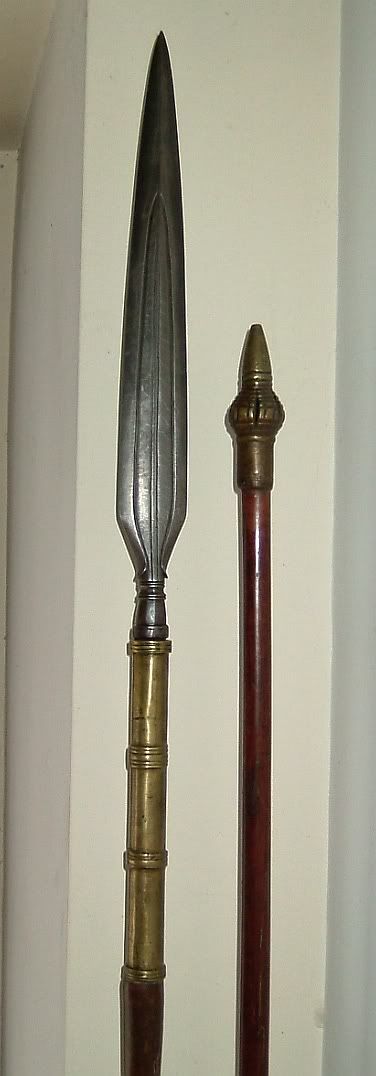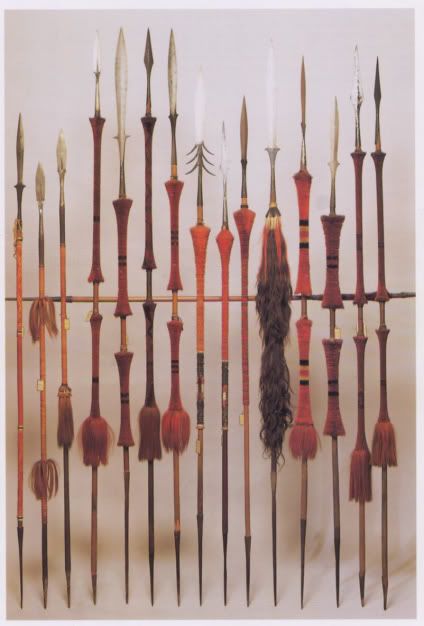
 |
|
|
#1 |
|
Member
Join Date: Sep 2005
Location: Ex-Taipei, Taiwan, now in Shanghai, China
Posts: 180
|
Hello,
I have a question about Asian tribal spears. I have noticed that nearly ALL the spears made by the Taiwanese aboriginal tribes have an iron nail-shaped point socketed at the bottom end of the shaft, opposite to the head : -Is this a very distinctive element of the Formosan spears or is this something that we can also widely see in the Philippines indigenous spears or among any other asian indigenous tribes spears ? I have checked around among the other Asian ethnic groups, but most of the time only the heads are pictured or drawn. When the whole shaft is, I didn't notice any nail-shaped point socketed at the bottom end. I know about the Taiwanese weapons, but not that much about the other ethnic groups in the Asia-Pacific area. What's your opinion ? You can see on my website two examples of Taiwanese Rukai spears with this iron nail-shaped extremity (www.formosatribal.com - click on Catalogue in the headlines, then go to Rukai). Thanks Nicolas |
|
|

|
|
|
#2 |
|
Member
Join Date: Dec 2004
Location: What is still UK
Posts: 5,925
|
Naga spears often have a spike end.
|
|
|

|
|
|
#3 |
|
Member
Join Date: Sep 2005
Location: Ex-Taipei, Taiwan, now in Shanghai, China
Posts: 180
|
Thanks Tim
I checked on the Internet for Naga spears and found the photo I attached after. I looked also for Philippines spears and found an illustration coming from a link from this forum. Here is the link : www.vikingsword.com/rila/k06.jpg I can find photos of spears heads but not many photos of the other end of the spears, in order to check if a spike is common or not in the Philippines spears, for example. Does someone has an answer or photos to show me ? Another question : What's the purpose of this spike/nail-shaped point ? I've been told it is made to help stick the spear in the ground and protect the holder against a charging wild pig. Nicolas |
|
|

|
|
|
#4 |
|
Vikingsword Staff
Join Date: Nov 2004
Posts: 6,378
|
Or not; you have a counterweight; and if it does break you have another sharp end to use.

|
|
|

|
|
|
#5 |
|
EAAF Staff
Join Date: Dec 2004
Location: Louisville, KY
Posts: 7,346
|
From older research at the turn of the 20th century Philippine Igorot tribal spears had the pointed end so that it would be easier for mountain climbing and when resting they would plant the spear in the ground with that spiked end down. Most Moro spears were actually lances and did not have this feature.
|
|
|

|
|
|
#6 |
|
Member
Join Date: Dec 2004
Location: What is still UK
Posts: 5,925
|
Naga spears with spikes from "The Nagas" Julian Jacobs. I did have one but in a moment of foolishness I let it go
 . .
|
|
|

|
|
|
#7 | |
|
Vikingsword Staff
Join Date: Nov 2004
Posts: 6,378
|
Quote:
 The cast one would make a nasty little club. 
|
|
|
|

|
|
|
#8 |
|
Member
Join Date: Dec 2004
Location: Philadelphia, Pennsylvania, USA
Posts: 54
|
You also see variations of the "spiked end" in China and SE Asia on various polearms.
I had assumed this was simply to protect the shaft itself. If you're a guard, and you spend a good part of your day standing around at attention with the butt-end of your spear touching the ground, I'd think there would be a real danger of an unprotected spear rotting (particularly in hotter climates, such as the rainforests of SE Asia). This would also explain why the Moro lances do not have this feature (you don't normally stand around at attention with a lance). |
|
|

|
|
|
#9 |
|
Member
Join Date: Mar 2006
Location: Room 101, Glos. UK
Posts: 4,259
|
greek and macedonian hoplite spears, sarissa had a square section counterbalance spike which was also usefull as a secondary weapon if the spearpoint broke or was cut off. it appears that a number of skulls found on ancient battle fields were found with square holes in them, it would have been convenient on the advance to spike your downed enemies as you went by to ensure they stayed down, while still presenting the main spearpoint towards the remaining foe. these SE Asian ones could be convergent evolution.
greek hoplite butt spike (top) & spearhead:  macedonian sarissa butt spike (upper left) & spearhead:  they also could be used to anchor the spear butt in the ground when being charged by cavalry to enhance the hedgehog effect. horses being smarter than their noble armoured riders will seek to avoid colliding with sharp pointy things (in spite of heroic stories and mel gibson movies) and tend to stop suddenly, throwing their riders, which is very embarrassing for the knight in shining armour, also why the british square with it's fixed bayonets was rarely broken by cavalry, the horses objected to being shish-kebabed. 
Last edited by kronckew; 10th July 2007 at 03:49 PM. |
|
|

|
|
|
#10 |
|
Member
Join Date: Sep 2005
Location: Ex-Taipei, Taiwan, now in Shanghai, China
Posts: 180
|
Thanks for the infos.
Here are the three Taiwan spears that just entered my collection. In this same post, the first one is Atayal, the second is Paiwan. In the second post, it is also a Paiwan one. Similarities with the Philippines spears, from Luzon mostly, seems to be very strong. Nicolas |
|
|

|
|
|
#11 |
|
Member
Join Date: Sep 2005
Location: Ex-Taipei, Taiwan, now in Shanghai, China
Posts: 180
|
The third spear, a Paiwan one.
|
|
|

|
|
|
#12 |
|
Member
Join Date: Sep 2005
Location: Ex-Taipei, Taiwan, now in Shanghai, China
Posts: 180
|
I don't know why but the images were mixed up in the first post.
So in that post, the Paiwan spear comes first, and the Atayal one is following. |
|
|

|
 |
| Thread Tools | Search this Thread |
| Display Modes | |
|
|